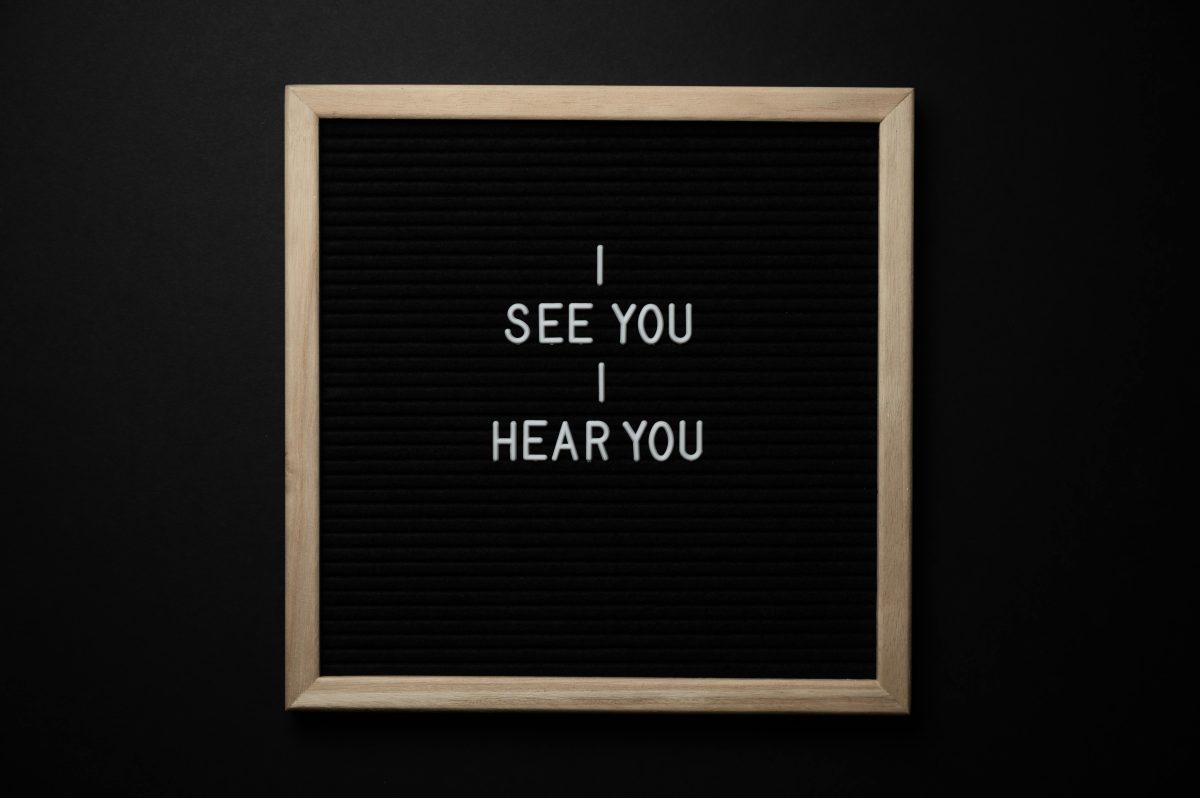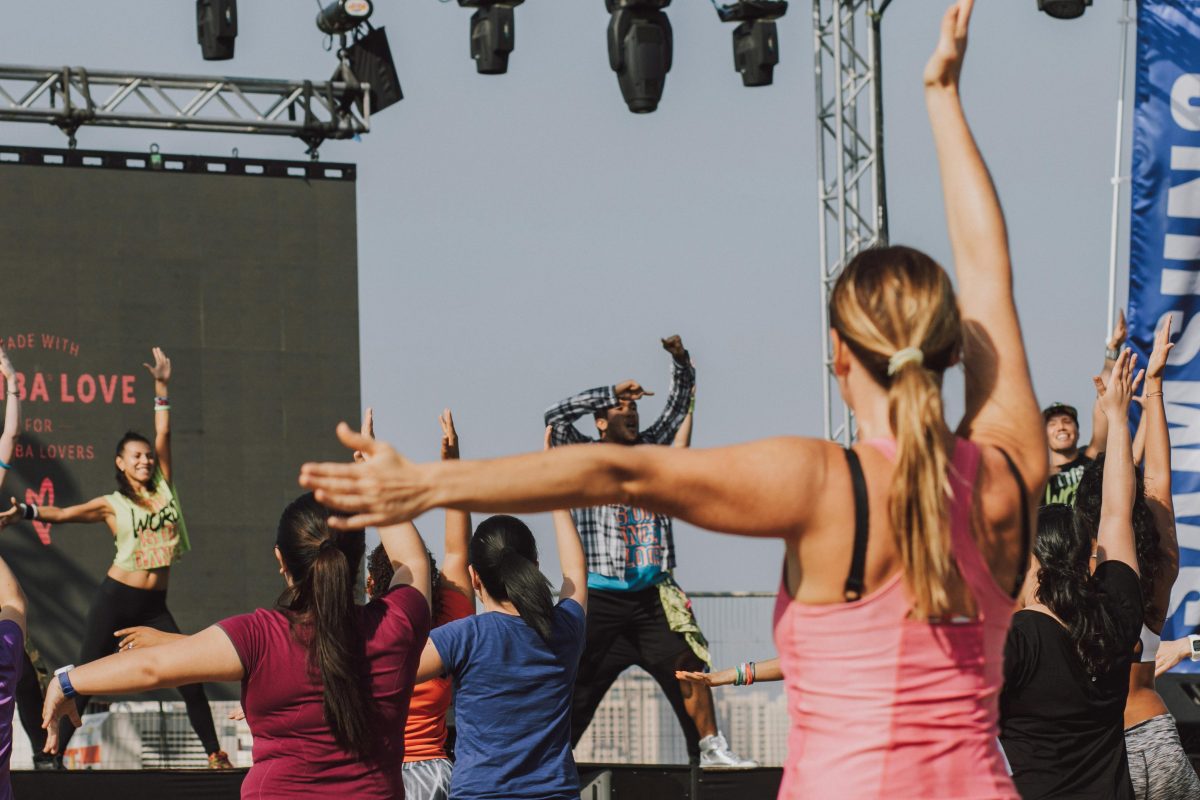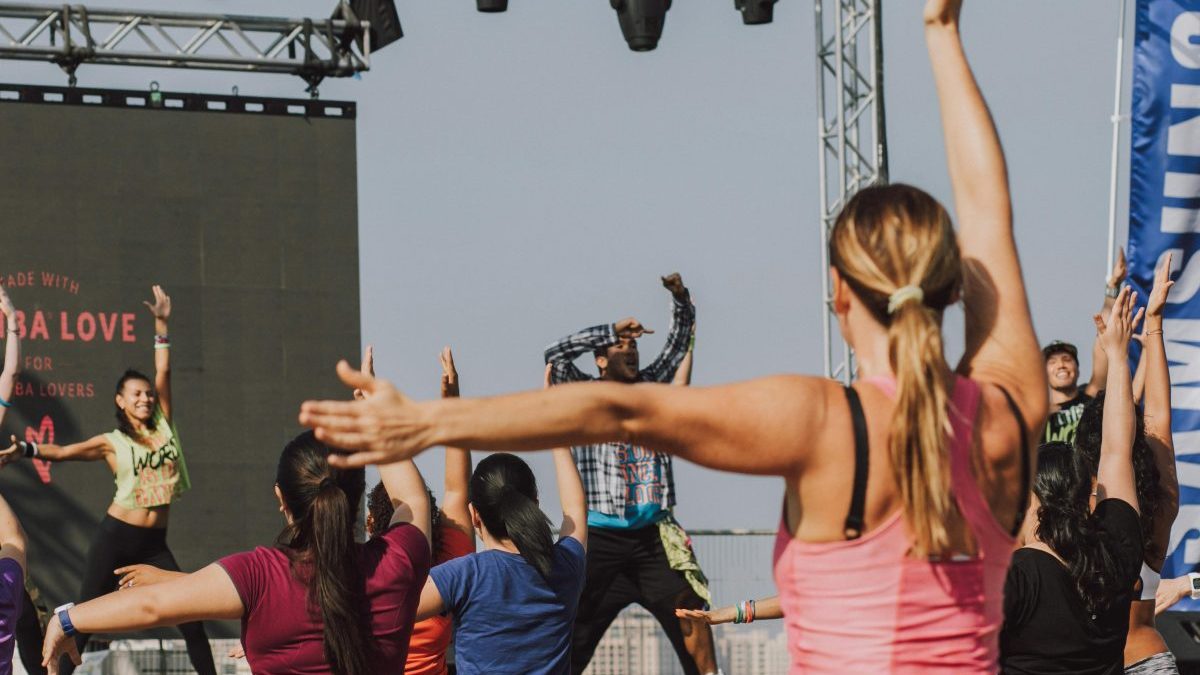Last Updated on: 14th July 2024, 08:54 am
Introduction to Zumba: A Global Fitness Phenomenon

Zumba’s inception in the 1990s revolutionized the fitness world, transforming a mistake into a global movement. It began when a Colombian fitness instructor forgot his regular music and improvised with his own mix of Latin and international tunes. This serendipitous blend of high-energy music and dance not only made exercise fun but also accessible to everyone.
The heart of Zumba lies in its fusion of Latin rhythms with international beats, creating an exhilarating atmosphere that feels more like a dance party than a workout session. Salsa, merengue, samba, and reggaeton moves are seamlessly integrated with global music to keep the energy high and the body moving. This unique combination ensures that every Zumba class is an invigorating and joyful experience.
But Zumba is more than just fun; it’s an effective workout that caters to all fitness levels. Its popularity lies in its ability to provide a comprehensive exercise session that combines cardio, muscle conditioning, balance, and flexibility, all while blasting calories. The infectious music and group setting create a motivating environment where participants can let loose, smile, and sweat their way to improved health.
The Science Behind Zumba: How It Works as a Fitness Program

Zumba, a dance-based workout, is not just about moving to the rhythm; it’s a scientifically designed fitness program that offers a plethora of health benefits. At its core, Zumba combines high-intensity and low-intensity movements, creating an interval training session that effectively boosts cardiovascular health. This dynamic approach to exercise ensures that participants experience an optimal heart rate, leading to increased endurance and a healthier heart over time.
- Calorie-burning potential: Depending on the intensity of the class and the individual’s body weight, participants can burn hundreds of calories in just one session.
- Psychological advantages: Engaging in dance-based workouts like Zumba has been shown to reduce stress and improve mood. The combination of music, movement, and social interaction triggers the release of endorphins, the body’s natural mood elevators.
In essence, Zumba offers a holistic approach to fitness, addressing physical, emotional, and social well-being. Its blend of dance and aerobic elements not only helps individuals achieve their weight loss and fitness goals but also supports mental health, making it a comprehensive workout option for people of all ages and fitness levels.
Zumba Varieties: Finding the Right Class for You

Zumba isn’t a one-size-fits-all workout. It’s a vibrant tapestry of classes, each designed to meet different needs and fitness levels. Whether you’re stepping into the world of fitness for the first time or looking to spice up your routine, there’s a Zumba class tailored just for you.
- Zumba Gold for Beginners and Older Adults: Focuses on improving balance, flexibility, and cardiovascular health. A gentle approach for everyone, regardless of age or fitness level.
- Aqua Zumba: Combining Water Resistance with Dance: The pool becomes your dance floor. This aquatic exercise blends the Zumba formula with water resistance, offering a low-impact, high-energy workout.
- Zumba Toning: Incorporating Weights for Strength Training: Elevates the challenge by integrating weights into the dance routines. Targets strength and muscle tone, focusing on areas like arms, legs, and core.
- Zumba Kids: Promoting Physical Activity Among Children: Designed for kids aged 7 to 11, it combines fun, energetic dance moves with child-friendly routines. A fantastic way to encourage physical activity from a young age.
Getting Started with Zumba: What You Need to Know

- Choosing the Right Class Level: Assess your current fitness level and goals. Beginners might consider Zumba Gold, while more vigorous workouts can be found in standard Zumba classes.
- What to Wear and Bring to a Zumba Class: Opt for breathable, moisture-wicking clothing and supportive sneakers. Don’t forget a water bottle and a towel.
- Tips for Beginners to Maximize Enjoyment and Prevent Injuries: Listen to your body, focus on mastering the footwork, stay hydrated, and stretch before and after class. Embrace the music and enjoy the community.
Zumba’s appeal lies in its blend of infectious music, dynamic dance moves, and a supportive community atmosphere. By choosing the right class, preparing adequately, and approaching each session with an open, positive mindset, beginners can unlock the full joy and health benefits of Zumba. Dance your way to fitness, and discover a workout that feels more like a celebration.
The Zumba Community: More Than Just a Workout

The social fabric of Zumba classes weaves together individuals from diverse backgrounds, creating a vibrant tapestry of stories and shared experiences. It’s not just about the steps or the music; it’s about the connections formed and the support system built within the community. Participants often describe the atmosphere as uplifting and inclusive, where every dance move fosters a sense of belonging.
Success stories and testimonials abound, painting vivid pictures of transformation and camaraderie. From significant weight loss journeys to overcoming personal challenges, the narratives highlight the profound impact of Zumba beyond physical fitness. These stories serve as powerful testaments to the motivational environment cultivated in each class, inspiring newcomers and regulars alike.
Connecting with the Zumba community extends beyond the physical confines of a class. Online platforms and social media groups offer spaces for members to share tips, celebrate achievements, and coordinate meet-ups. Whether it’s through a local Facebook group or the official Zumba website, finding your tribe has never been easier. Offline, Zumba events and charity fundraisers provide additional avenues for engagement, allowing enthusiasts to dance for a cause and deepen their connections within the community.
At its core, Zumba transcends the traditional workout, embedding itself into the lives of its participants as a source of joy, support, and inspiration. It’s a global movement that champions wellness, friendship, and the transformative power of dance.
Incorporating Zumba into Your Fitness Routine

Integrating Zumba into your fitness regimen offers a refreshing change of pace, complementing traditional workouts with its vibrant energy. To achieve a well-rounded routine, balance Zumba with strength training and flexibility exercises. This fusion ensures all muscle groups are engaged and enhances overall fitness.
- Set realistic goals – Aim for consistency rather than perfection, gradually increasing intensity and frequency.
- Enjoy the journey – It’s not just about the number of classes, but also enjoying the journey towards a healthier you.
- Track your progress – Note improvements in stamina, strength, and how you feel overall. Celebrate milestones, no matter how small.
- Stay motivated – Remind yourself of the joy each Zumba session brings. With each step and beat, you’re dancing closer to your fitness goals.
Staying Motivated with Zumba
Staying motivated in your Zumba journey is key. Mix up your routines with different Zumba styles to keep things exciting. Set short-term goals and reward yourself upon achieving them. Connect with the Zumba community for support and share your progress. The collective energy will fuel your commitment, making fitness a celebration of movement and music.
Beyond the Dance Floor: The Lifestyle Impact of Zumba

Nutritional Considerations for Active Zumba Participants
Embarking on a Zumba journey transforms not just how you move, but also how you fuel your body. Active participants should prioritize a balanced diet, rich in nutrients, to sustain energy levels and aid in recovery.
- Lean proteins, whole grains, and a colorful array of fruits and vegetables – Ensures your body gets the essential vitamins and minerals it needs.
- Hydration – Drinking plenty of water before, during, and after classes keeps you energized and helps prevent fatigue.
The Role of Rest and Recovery in a Balanced Fitness Regimen
While the rhythm of Zumba encourages constant movement, rest and recovery hold equal importance in a balanced fitness regimen. Allowing your body time to heal and rejuvenate is essential.
- Incorporate rest days into your schedule.
- Consider practices like yoga or meditation to aid in muscle recovery and mental well-being.
Zumba as a Gateway to a Healthier Lifestyle and Improved Well-Being
Zumba, with its infectious energy and supportive community, often serves as a gateway to a healthier lifestyle. Participants find themselves more motivated to make positive life changes, extending beyond the dance floor.
- The joy and satisfaction derived from Zumba classes can inspire a more active daily life, better nutritional choices, and a commitment to self-care.
- This transformative power of Zumba not only enhances physical fitness but also uplifts mental health, fostering an overall sense of well-being.
As you dance your way through each Zumba class, remember, it’s more than just a workout. It’s a journey towards a healthier, happier you, with each step on the dance floor leading you closer to achieving your fitness and wellness goals.
In Closing
Zumba transforms fitness into a joyous celebration. It marries fun with physical well-being, creating a unique, invigorating experience. Through its blend of dance and fitness, Zumba offers a holistic approach to health, catering to both the body and the mind. It encourages a vibrant lifestyle, fostering community, and personal growth. Embrace the rhythm of Zumba, and step into a healthier, happier life.
Zumba: Dance Your Way to Fitness FAQs
Yes, children can participate in Zumba through programs specifically designed for them, such as Zumba Kids. These classes offer modified routines suitable for younger participants, focusing on movement, games, and activities that are fun and appropriate for their age group. It’s a great way for children to stay active, learn about rhythm and coordination, and develop a positive attitude towards exercise.
Yes, Zumba can help with weight loss by providing a high-calorie burn through aerobic activity combined with resistance training. A typical hour-long session can burn between 300 to 900 calories, depending on the intensity of the workout. Regular participation, coupled with a healthy diet, can lead to significant weight loss over time.
Zumba can significantly improve your overall fitness by enhancing cardiovascular health, flexibility, and strength. The dance routines incorporate movements that target different muscle groups, offering a full-body workout. Regular sessions can lead to improvements in endurance, muscle tone, and coordination.
No special equipment is required for Zumba, making it an easily accessible workout for many. Participants just need enough space to move around and a water bottle to stay hydrated. Some classes might incorporate light weights, but they are usually provided by the instructor.
Zumba differs from traditional dance classes by emphasizing fitness over precise dance technique. It’s designed to get people moving and sweating using easy-to-follow dance moves combined with fitness elements. This approach makes it more accessible to those who are more interested in a fun, high-energy workout than mastering complex dance choreography.
To see results, it’s recommended to do Zumba 2-3 times a week. Consistency is key, as it helps improve cardiovascular health and aids in weight loss when combined with a balanced diet. Over time, participants can see improvements in stamina, muscle tone, and overall fitness levels.
Zumba is suitable for beginners, as it offers different levels of intensity and modifications for various exercises. Instructors often provide alternatives for any move, making it accessible for people of all fitness levels. Starting with Zumba can be a fun and effective way to get into fitness without needing prior experience.
Zumba is a fitness program that combines Latin and international music with dance moves. It incorporates interval training — alternating fast and slow rhythms — to help improve cardiovascular fitness. This approach makes it an enjoyable way to help people lose weight and improve their overall health.
For a Zumba class, wear comfortable, breathable clothing that allows for full range of motion. Supportive sneakers with good cushioning are important to protect your joints during the high-impact moves. Avoid running shoes, as they can stick to the floor during lateral movements.
Zumba classes use a variety of music types, primarily focusing on Latin genres such as salsa, reggaeton, merengue, and samba. However, instructors also incorporate international beats, including Bollywood, African, and pop, making every class a diverse and engaging experience. This wide range of music keeps the classes exciting and appealing to a broad audience.
Orlando is a all round athlete from Australia, now resident in Germany. His sports of passion of American Football(Offensive line), weight training and indoor rock climbing where he uses his 195cm wing span to his advantage.



